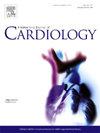Predictive value of left atrial strain for left ventricular reverse remodeling in dilated cardiomyopathy
IF 3.2
2区 医学
Q2 CARDIAC & CARDIOVASCULAR SYSTEMS
引用次数: 0
Abstract
Background
Early prediction of left ventricular reverse remodeling (LVRR) can guide the subsequent treatment in dilated cardiomyopathy (DCM) patients. We aimed to investigate the value of left atrium (LA) strain for predicting LVRR in DCM patients.
Methods
Clinical and imaging data of DCM patients were gather between January 2018 and January 2023. The participators were divided into LVRR group and non-LVRR group according to the ultrasound follow-up results. CMR images were process to yield LA fast long-axis strain parameters. Univariate and multivariate logistic regression analysis was used to screen the predictors and establish the prediction model.
Results
The study included 116 participants. LVRR occurred in 69 participants within 1 year. Compared with the non-LVRR group, the LVRR group has smaller left ventricular end-diastolic volume index (LVEDVi), late gadolinium enhancement extent (LGE%) and higher left atrial passive eject fraction (LAPEF), left atrial reservoir strain (LARS) and left atrial conduit strain (LACS). In multivariable logistic regression analysis, LVEDVi (HR: 0.990; 95 % CI: 0.981, 0.999; P = 0.037), LACS (HR: 1.434; 95 % CI: 1.025, 2.007; P = 0.035) and LGE% (HR: 0.713; 95 % CI: 0.584, 0.870; P = 0.001) were independent predictors of LVRR. The model based on NYHA, LVEDVi, LGE% and LACS had a better performance in predicting LVRR (AUC = 0.807; 95 % CI: 0.723; 0.874).
Conclusions
LVEDVi, LACS and LGE% were independent predictors of LVRR within 1 year in DCM patients. The combination of NYHA, LVEDVi, LACS and LGE% has a better predictive performance.
求助全文
约1分钟内获得全文
求助全文
来源期刊

International journal of cardiology
医学-心血管系统
CiteScore
6.80
自引率
5.70%
发文量
758
审稿时长
44 days
期刊介绍:
The International Journal of Cardiology is devoted to cardiology in the broadest sense. Both basic research and clinical papers can be submitted. The journal serves the interest of both practicing clinicians and researchers.
In addition to original papers, we are launching a range of new manuscript types, including Consensus and Position Papers, Systematic Reviews, Meta-analyses, and Short communications. Case reports are no longer acceptable. Controversial techniques, issues on health policy and social medicine are discussed and serve as useful tools for encouraging debate.
 求助内容:
求助内容: 应助结果提醒方式:
应助结果提醒方式:


